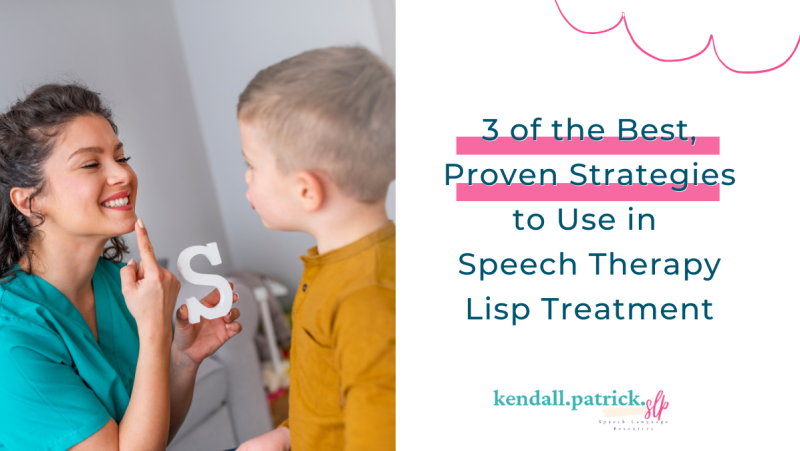Speech therapy – lisp treatment can be difficult, but it does not have to be! I have talked about different articulation and phonological treatment approaches before, but here are some of my go-to treatments for lisps in speech therapy.
Check out my blog post on different therapy approaches here.
Sign up with your email address here to get access to my free library (growing all the time) full of some of my goodies made exclusively for my followers.
What is a lisp?
A lisp is a speech delay or disorder, most commonly related to the /s/ and /z/ sounds, but can also affect other fricatives and affricates including: /sh/, /ch/, and /dg/.
A frontal lisp (also called interdental or dental) occurs when the tongue is forward in the mouth, protruding through the teeth, sounding like a /th/ sound or produced with the tongue on the teeth during sound production.
A lateral lisp occurs when air slides over the tongue, out the sides of the mouth. In this occurrence, the /s/ sound sounds slushy, like there is extra saliva in the mouth during sound production.
Frontal Lisp
A frontal lisp can be a typical part of normal speech development and may not fade until age 4-5. It is often seen as a “cute” sound error, especially when kids are very young. I, myself, have been guilty of this as my 3 year old currently speaks with a frontal lisp and I think he is just about the cutest thing ever! But once it is no long developmentally appropriate, however, it really should be addressed with formal speech therapy services.
Lateral Lisp
A lateral lisp on the other hand, is not part of typical speech development. This is an atypical error and therefore a speech disorder, rather than a delay. Treatment for this type of lisp should not be delayed due to age or development, and should begin as early as possible (when the child is ready for traditional articulation therapy).
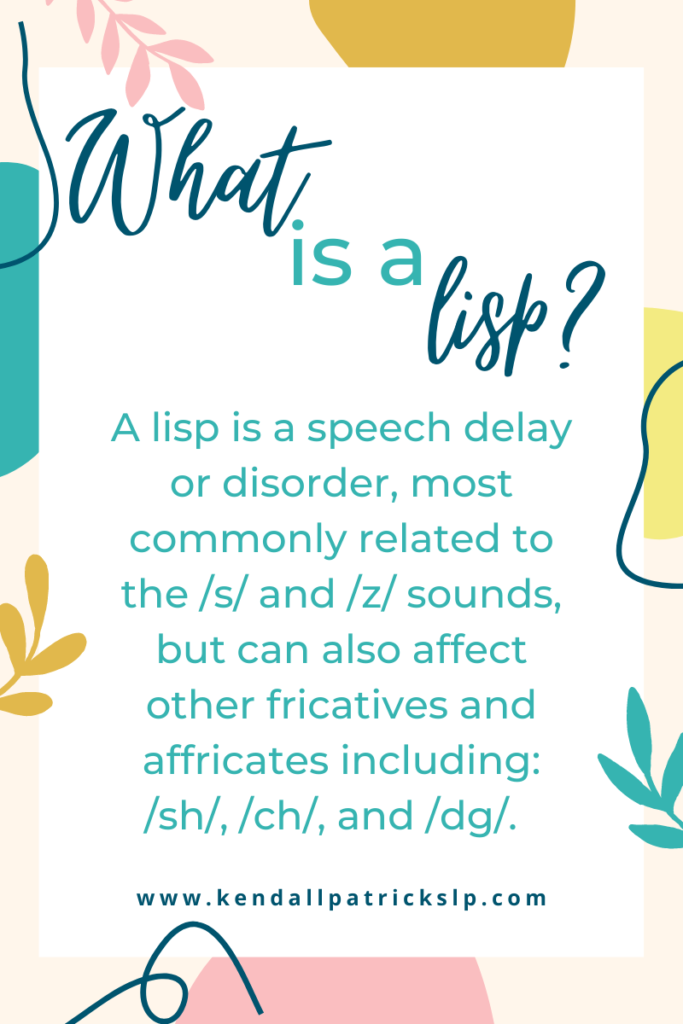
Parents May Ask: What Causes a Lisp in Speech Production?
As with many sound errors, there can be multiple reasons for a delay or disorder, and oftentimes we don’t really know the cause. Sometimes we see patterns in families and sometimes we don’t. There are a few known causes of some lisps though:
- Jaw alignment – if the jaw protrudes forward, then the tongue sits further forward in the mouth, making a frontal lisp more likely
- Pacifier use – while it is certainly not the cause of all lisps, it can cause atypical airflow if a toddler/preschooler is using a pacifier while talking
- Frequent ear infections can be a factor in speech sound disorders, including those that cause lisps
- Family history can also play a role
What Age for Treatment?
Articulation refers to how we make speech sounds using our articulators (mouth, lips, and tongue). For example, we need to be able to say the /l/ sound in order to say “lunch” instead of “wunch” or “yunch.” (ASHA)
By age 5, most children can produce 90% of consonants correctly (Source: McLeod and Crowe, 2018).
Typical age that consonant sounds are mastered:
| Age 2 | /p/ |
| Age 3 | /b, m, d, n, h, t, k, g, w, ng, f, y/ |
| Age 4 | /l, j, ch, s, v, sh, z/ |
| Age 5 | /r, zh/, voiced /th/ |
| Age 6 | voiceless /th/ |
Source: McLeod and Crowe, 2018
For a free download of the above chart and information, check out my free resource library. I have an instant download that you can print and have ready to share with parents as needed.
Let’s use that tricky /r/ sound as an example. For years, it has been assumed that /r/ is a much later developing sound and shouldn’t be addressed until age 8 or 9. But what if I told you that was way off base and you could have much more success starting earlier? The truth is, while /r/ may very well be a “later developing sound,” most children have developed 90-100% of speech sounds by age 5, with initial and vocalic /r/ sounds developing by age 5-6.
What can we learn from this?
Sometimes it IS appropriate to pick up that kinder or first grader to work on /r/ AND you may just get better quicker results. Which leads to fewer life-longers in speech! Win for everyone.
While outdated norms and thinking about “how it’s always been done” may suggest waiting to treat some of these sounds, it’s time to update what we’re doing. If you look at the chart above, you’ll notice that the majority of sounds are typically developed by age 3-4. By age 4, you should be able to understand 90% (or more) of what a child says. So in most cases, it’s totally appropriate to start working on articulation in our preschool populations. Not only appropriate, but best practice as early intervention is the key to success!

Why Speech Therapy is Important for Most Lisps
The /s/ and /z/ sounds are typically developed by age 4-5. Some lisps are typical in speech development but should be resolved by age 5 in most cases. Other types of lisps are not typical in speech development and will most likely require speech intervention at any age.
Speech Therapy for Lisp
The traditional approach is commonly used in speech therapy and I use it quite often with a lot of my students. This method refers to the articulation therapy that focuses on one sound at a time and you practice at each level (isolation, word, phrase, sentence, etc.) until mastery is reached and then move on to the next. I use this with my students with just a couple of error sounds, but typically my kiddos working on multiple phonological processes don’t make quick progress with this method. So I don’t really find this approach to be the most effective in these cases.
Speech Therapy Lateral Lisp
- /t/ placement – if the child has a proper /t/ and /d/ sound (with correct tongue placement), use this to elicit a proper /s/ sound. Have the child say /t-t-t-t-t/ very quickly until it turns into an /s/. This will force the air out the front of the mouth instead of the sides because the tongue tip will be in the correct place.
- Straw technique – cut off a straw to a couple of inches and have the child place the straw against the top of their mouth, so the end is near the midline. Then elicit the /s/ sound, having the child push the air through the straw so that it all comes out the front of the mouth, instead of the sides. Use the /t/ sound placement if needed to begin.
- Teach a frontal lisp placement – if other techniques do not work, I will teach the child to make a frontal lisp (interdental tongue placement) in order to get the airflow correct. Once the airflow is accurate, then I work to bring the tongue position back for a proper /s/ sound.
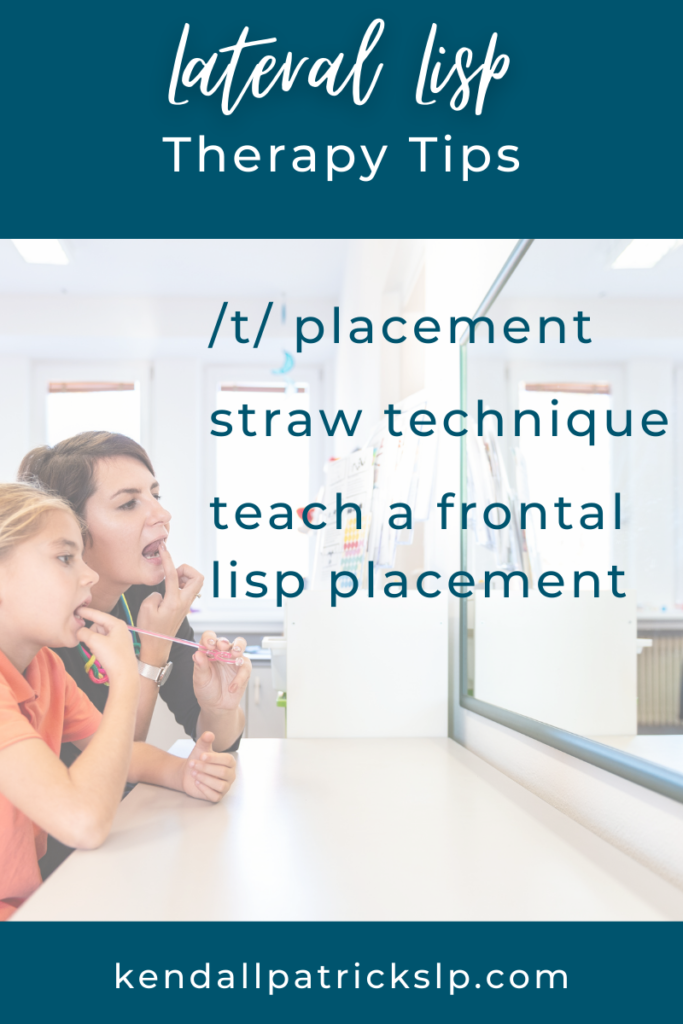
Speech Therapy Frontal Lisp
- Mirror – when the frontal lisp is interdental and the tongue protrudes through the teeth, I like to use mirrors while teaching them to pull their tongue tip back and show their teeth. The visual cue of the mirror helps remind them to keep their tongue back.
- Then I teach them to keep their tongue off the back of their teeth (dental lisp) and to gently place the tip of their tongue near the tiny bump on the top of their mouth, just behind their top teeth. This gives them a place holder that is not their teeth, while still keeping the airflow out the front.
- /t/ placement – if the child has a proper /t/ and /d/ sound (with correct tongue placement), use this to elicit a proper /s/ sound. Have the child say /t-t-t-t-t/ very quickly until it turns into an /s/. This will force the tongue tip to be in the correct place.
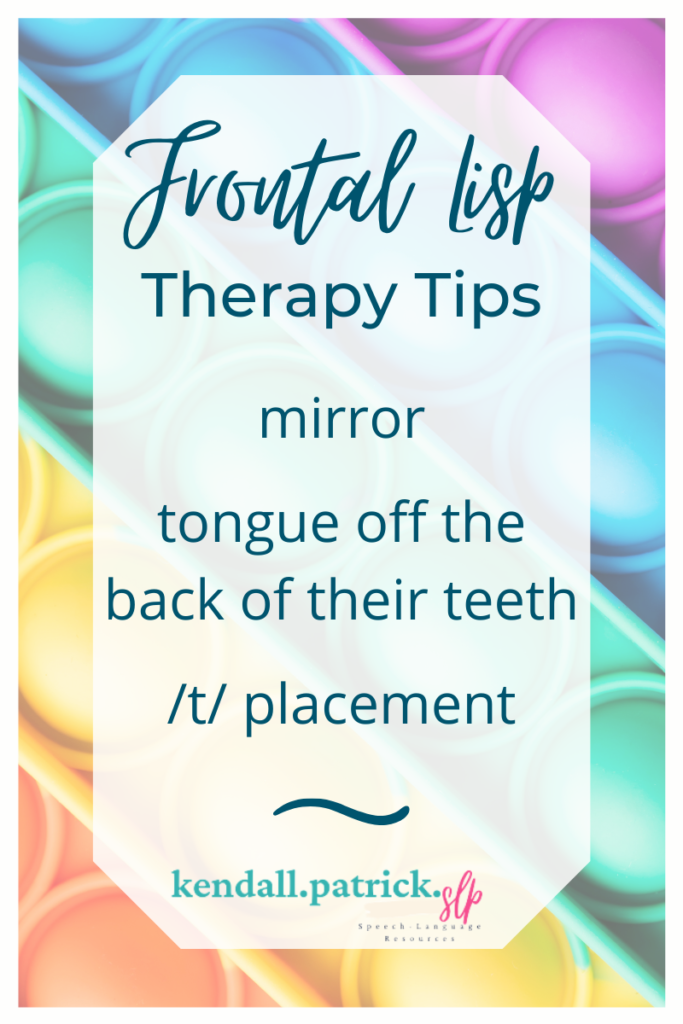
Speech Therapy Lisp Exercises and Activities
These are some of the cues I use when teaching the /s/ and /z/ sounds:
- Verbal: “Use your tongue to find the little bump on the roof (top) of your mouth. Place the tip of your tongue on that spot and blow air out”
- Tactile: Drag a finger along the surface as a reminder to make a continuous sound.
For printable sound cue cards that include multiple types of cues: auditory, visual, verbal, and tactile, check out this product in my store.
There are many different types of cues in speech therapy that can be used and students benefit from a variety of types and combinations. These speech sound cue cards are the perfect addition to your therapy room if you are looking for quick, easy ways to provide more speech sound cues.
What’s Included:
A one-page visual for the following sounds:
- /t/ & /d/
- /p/ & /b/
- /k/ & /g/
- /f/ & /v/
- /s/ & /z/
- /sh/
- /ch/ & /dg/
- /l/ & /r/
Each page includes auditory cues (with sound), visual cues, verbal cues, and tactile cues.
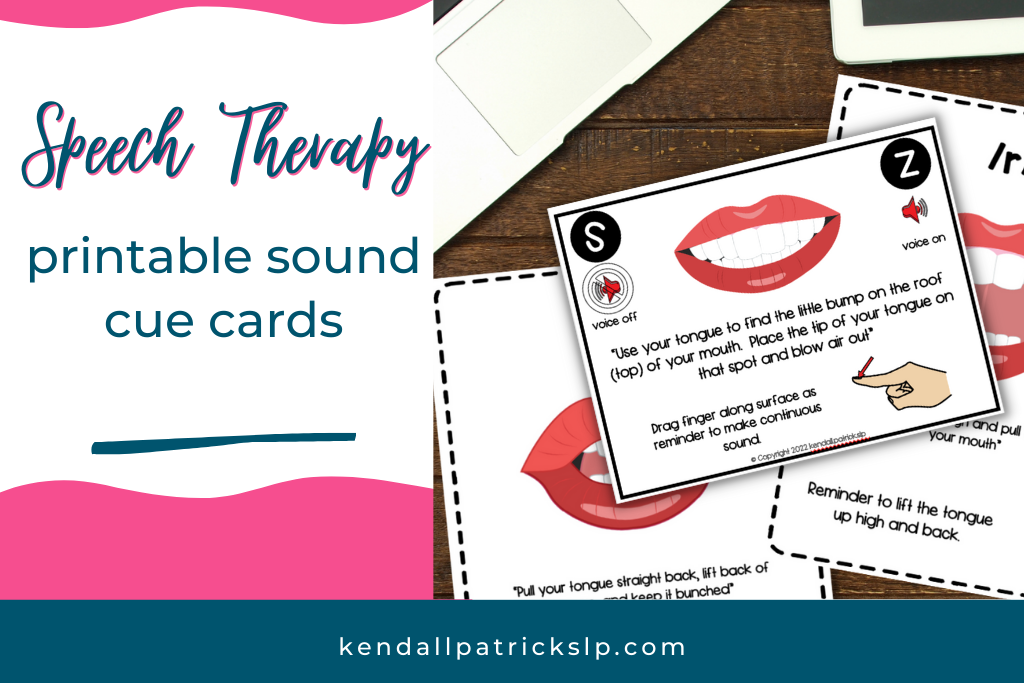
Speech Therapy Techniques for Articulation
Visual & Verbal Cues
- Modeling
- Pointing to/drawing attention to your mouth/articulators
- Using a mirror so they can see their own articulators
- Auditory Bombardment
- Amplification
Auditory Cues
- Amplification
- Auditory Feedback
Tactile Cues
- Tools used in the mouth (e.g., tongue depressor, lollipop, Speech Buddy Tool)
- Gestural cues
Articulation Therapy Techniques pdf
Click here for a free download that outlines articulation therapy techniques to keep these tips close by for whenever you need them!
Games
There are so many fun and engaging games and activities you can use to work on /s/ and /z/ sounds in therapy.
- Matching games (great for minimal pairs work)
- Books with frequently occurring /s/ and /z/ sounds
- Toss Games (bean bags, balls, bowling)
- Go Fish with arctic cards
- Movement Games (Musical Stepping Stones)
- Interactive Worksheets
*For more books to use in therapy, check out https://booksharetime.com/. You can search for books to use in therapy by language goals/targets, age, speech sounds… It really is a great FREE resource!
One of my favorite, super-simple go-to activities for those times when you just need to get moving, is a musical stepping stones game!
- First, I put out pictures in a large circle around the room*
- I put velcro on the back of mine because I have carpet squares in my room, but you could do tape too if you have tile (to prevent slipping)
- When the students arrive I have them each stand on a picture
- We review the rules (e.g., no running, no skipping in line, when the music stops, you stop, etc.)
- I start the music!
- When the music stops, they stop on whatever picture they are on/closest to and complete their individual task (say the word or phrase with their target sound, or maybe just practice in isolation)
Printables
I have a few different types of printables in my store for working on /s/ and /z/ sounds including sound worksheets, foldables, color-by-code articulation sheets, and crafts.
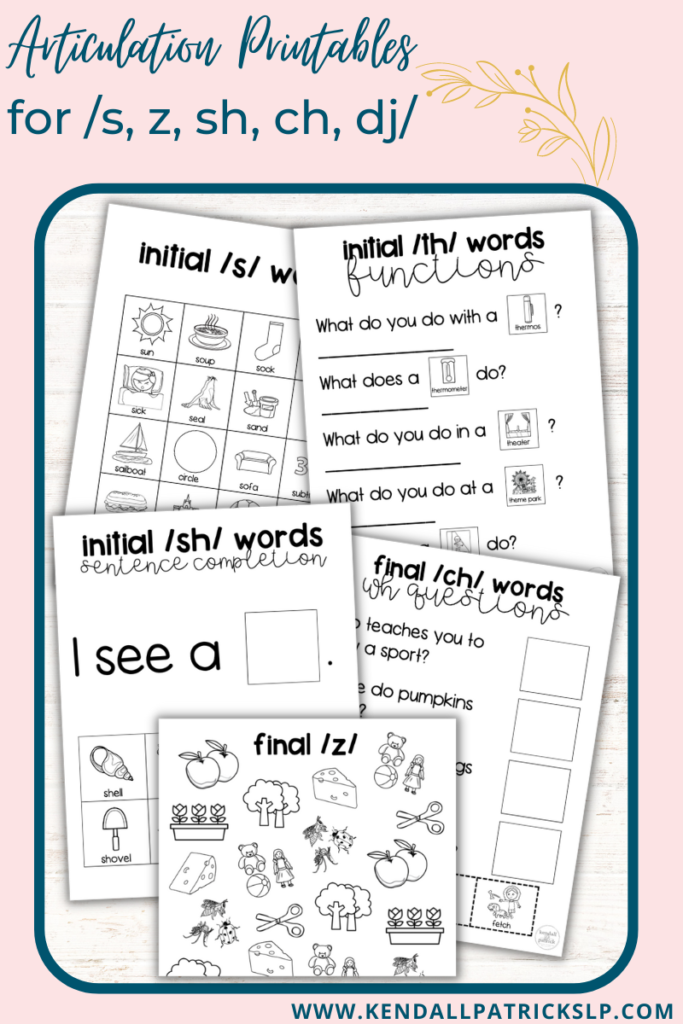
These are excellent articulation activities for preschoolers and school-age students. The no-prep articulation activities include worksheets, reinforcers, and sentence-level articulation activities for carryover.
What’s Included:
- Target words for initial and final /s, z, sh, ch, dg, th/
- Coloring pages to use as reinforcers or home practice for all the above sounds
- Sentence completion pages for all the above sounds
- “wh” questions and functions questions for all the above sounds
- large coloring pages (2 for each sound/position)
Tips for Use:
- Use the target word pages to teach the sound patterns, use them for drill/repetition, student coloring pages, or homework
- Use the reinforcer pages with or without a dice for additional practice
- Use the sentence completion tasks to target in connected speech
- Use the “wh” questions and functions pages to target language goals while still getting in additional trials for speech targets
- Send copies of any of the pages home for practice with instructions for parents or keep them in a student folder that goes between school and home
Grab these free /st/ sheets in my free resource library now!
For more speech therapy – lisp treatment ideas:
Speech Therapy for a Frontal Lisp from Speech and Language Kids
Exercises to Improve a Lateral Lisp from Spectrum Speech
The “secret” to correcting lateral lisps… from Graham Speech Therapy, LLC
Don’t forget to sign up with your email address here to get access to my free library (growing all the time) full of some of my goodies made exclusively for my followers.
I hope you found some of these ideas helpful and can use one or more in your therapy room. Please leave a comment or shoot me an email if you want to share some of your favorite speech therapy – lisp treatment ideas.

